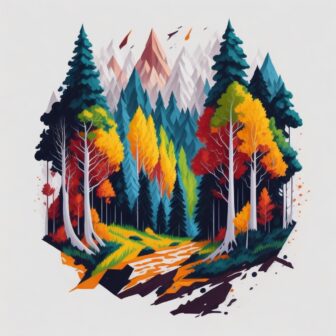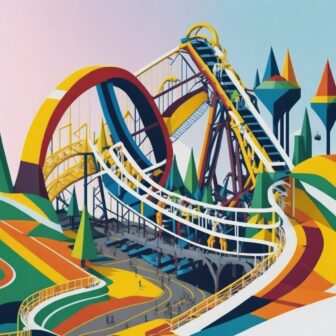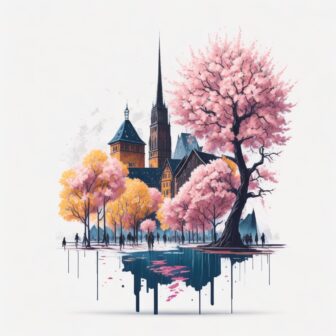Spring in Germany
When the sun shines brighter again after the long, gray winter days, we are all drawn out into nature. What could be nicer than enjoying the first rays of sunshine surrounded by a sea of flowers. That quickly drives away the frustration of winter. We show you where the German spring is particularly beautiful.
The colder and longer the winter, the more we look forward to the sun in spring and the first cappuccino in a street café or the first beer in the beer garden. Everywhere you see people strolling in the parks and life awakens again. But where are the places where spring is particularly beautiful in Germany?
When is Spring in Germany?
Spring, also known as “Lenz”, is one of the four seasons. In the northern hemisphere, meteorological spring begins on March 1st and consists of the months of March, April and May. The reason for this determination was that entire months were easier to statistically evaluate. In addition, however, it was also found that the meteorological seasons reflect the climatic situation of the seasons in most parts of Germany better than the astronomical seasons.
Astronomical or calendar beginning of spring
Astronomically and calendrically, spring begins when day and night are exactly the same length, which occurs on March 20 or March 21 of each year. Spring 2022 begins on March 20 at 4:33 p.m
Beginning of phenological spring
A not-so-simple answer is obtained by associating the onset of spring with the phenological seasons. In phenology, the growth and development phenomena of plants that periodically recur over the course of the year are considered and divided into phases. According to the phenological clock, there are three phases in spring: early spring, first spring and full spring. Their beginning can be determined by so-called leading or substitute phases. The lead phase for early spring is the start of flowering for hazel, for early spring for forsythia and for full spring for apple trees. For the respective phases, an average starting date could be found from observations in recent years. Accordingly, early spring begins on average on February 13th, first spring on March 26th and full spring on April 27th.
Statistical beginning of spring
Another answer to the question of when spring will come can be found from statistical considerations. To do this, we define (rather arbitrarily) a “statistical beginning of spring”, whereby a maximum temperature of over 15 degrees is to be reached on at least two days on three consecutive days and it is predominantly dry and clear. Looking at the past 11 years, according to these criteria, spring began on average on March 15 in the south (represented by the city of Munich) and on April 1 in the north (represented by Hamburg).
What to wear in Spring in Germany
Now, just because meteorologists consider March, April, and May as spring months, that doesn’t mean you won’t see a flurry of snow in April. So, it’s best not to get your hopes up too soon when the sun starts to shine in March. To stay comfortable during this time of year, be sure to dress in layers, including a light scarf, a jumper, a jacket, and, most importantly, bring an umbrella.
RELATED:
What to wear in March in Germany
You’ll want to pack clothing that will keep you comfortable in the cooler weather. While temperatures do gradually warm up as the month goes on, it’s still chilly in most of northern Germany.
Make sure to bring a warm winter jacket, as well as other warm layers like sweaters, scarves, and hats. Comfortable walking shoes are a must, as you’ll likely be doing a lot of exploring on foot.
During the day, dress casually with jeans, pants, and long-sleeved shirts. Keep in mind that if you plan to visit any religious sites, it’s respectful to wear clothing that covers your shoulders and knees.
For evenings out, bring dressier outfits for nicer restaurants and events. Men can pack a collared shirt and dress pants, while women can opt for a nice dress or blouse and skirt.
Don’t forget to also pack an umbrella or raincoat, as March in Germany can be quite rainy. With the right attire, you’ll be able to enjoy all that Germany has to offer while staying warm and stylish.
RELATED:
What to wear in April in Germany
You’ll want to pack clothing that will keep you comfortable in the changing weather. While April can bring some warmer days, it’s still a good idea to pack some layers for cooler temperatures and occasional rain showers.
Make sure to bring a lightweight jacket or raincoat, as well as comfortable walking shoes for all your sightseeing adventures. For daytime attire, casual clothing like jeans, pants, and t-shirts are appropriate for most situations.
If you plan on visiting any churches or religious sites, it’s important to bring clothing that covers your knees and shoulders as a sign of respect.
April in Germany also brings Easter celebrations and several public holidays, so be prepared for crowds and festivities. Dressier outfits are appropriate for nicer restaurants and events, with men wearing a collared shirt and dress pants, and women wearing a nice dress or blouse with a skirt.
Overall, when packing for a trip to Germany in April, remember to bring layers and dress for the unpredictable weather. With the right attire, you can enjoy all that Germany has to offer while staying comfortable and stylish.
RELATED:
What to wear in May in Germany
If you’re traveling to Germany in May, it’s important to pack smart and be prepared for the changing weather. May is a transitional month, with some days being warm and others cooler with occasional rain showers.
To be ready for anything, bring some layers that can be easily added or removed as needed. Don’t forget to pack a lightweight jacket or raincoat and comfortable walking shoes for your sightseeing adventures.
During the day, dress comfortably and casually with jeans, shorts, and t-shirts being appropriate for most situations. Keep in mind that if you plan to visit churches or other religious sites, it’s respectful to wear clothing that covers your shoulders and knees.
For your evenings out, dress up a bit with dress pants and a collared shirt for men, or a nice dress or blouse with a skirt for women. This will ensure you’re ready for any nicer restaurants or events.
RELATED:
Spring Festivals in Germany
Here’s some good news! If you’re traveling to Germany during the spring months, you’re in for a treat. There are several public holidays or “Feiertage” during April and May that are recognized nationwide, making it feel like there’s an extra day off every other week.
Keep in mind that while the 16 German states have their own holidays, many of the Feiertage are celebrated all over the country. So, make sure to plan your trip accordingly to join in on the festivities!
Ah, the joys of springtime in Germany! While most people know Munich for Oktoberfest, savvy travelers know that the real fun begins in the spring with Frühlingsfest, the lesser-known but equally festive sister festival.
Frühlingsfest is a staple of the German springtime calendar, with celebrations taking place all over the country. However, the biggest and most popular events happen in Munich and Stuttgart.
Frühlingsfest in Munich
Munich’s Frühlingsfest is hosted on the same Theresienwiese fairground as Oktoberfest and is a true celebration of springtime. Fairground rides, flea markets, dancing performances, and of course, beer abound. And just like Oktoberfest, traditional garb is encouraged, so don’t forget to pack your lederhosen or dirndl.
Frühlingsfest in Stuttgart
Stuttgart’s Frühlingsfest is also a lively affair with plenty of rides, games, and, of course, beer. It’s the perfect way to welcome in the warmer weather and enjoy the company of locals and visitors alike.
Whether you’re a seasoned traveler or a first-timer, Frühlingsfest is not to be missed. You won’t regret it.
RELATED:
Spring Celebrations in Germany
As springtime arrives in Germany, so does the celebration of May Day, or erster Mai. While this public holiday has a complex history, today it is celebrated as Labour Day across the country. However, it is in Berlin where the festivities truly come alive.
Thanks to its vibrant and storied history, Berlin is the epicenter of May Day events in Germany. The Kreuzberg neighborhood, once known for its artist squats and punk scene, was the site of violent clashes between squatters and police in the years leading up to and following the fall of the Berlin Wall. These clashes came to a head on May 1, 1987, when riots and demonstrations erupted throughout the neighborhood.
Since then, the annual march in Kreuzberg has been renamed the Revolutionäre 1. Mai Demo (Revolutionary May 1 demo), and its slogan, inspired by the famous German activist Rosa Luxemburg, is “Die Revolution ist großartig, alles andere ist Quark” (The revolution is magnificent, everything else is quark).
Each year, demonstrations advocating for better working conditions, wages, holidays, and workplace organization take place throughout Kreuzberg and across Germany. So if you happen to find yourself in Berlin on May 1, be sure to join in the festivities and experience the passion of the city’s labor movement.
Spring destinations in Germany
Our native nature has more to offer than one might think. Especially in spring it blooms in many regions in all shades of color. These plants often smell beguiling. Above all, the alpine valleys and slopes with their colorful mountain meadows are well known. Here are a few lesser-known places.
Orchid paradise Rothenstein, Thuringia
Sometimes military training areas also have something good. The former Spitzberg - Rothenstein - Borntal shooting range near Jena is such a place. Since civilians had no access here for decades, a unique variety of plants could be preserved. Since 2007, NABU has created a nature reserve, now 544 hectares in size, in which 32 protected plants bloom.
During the flowering period in May, NABU organizes guided hikes. You will be amazed at the magnificent flowers that grow here. But please only take photos for your Insta account and do not pick or dig up.
Polenztal, Saxon Switzerland
The March cups are a little earlier in bloom in this valley near Hohnstein near Pirna. These are among the very first flowers to open their buds in spring.
The city of Stolpen has introduced a March mug diary so that you don’t miss the right time. During the flowering period, the meadows in this valley shine in a unique white.
Drehbach in the Ore Mountains
Another flower that is one of the first to bloom in spring is the crocus. According to legend, the local pastor, who was also a doctor, treated Elector John George II after a hunting accident. As a thank you, he was allowed to get three plants from the electoral botanical garden. One of them was the crocus.
For 300 years now, the blossoms have been transforming the town’s meadows into a purple paradise in spring. When the weather is nice, the locals even organize an accompanying programme.
Monschau in the Eifel
Near the picturesque town of Monschau in the Eifel on the Belgian border, the Perlenbach-Fuhrtsbachtal nature reserve shines in yellow every spring. Around Easter, around 10 million wild daffodils bloom here.
A real spring firework, what Mother Nature fires for us. You must have seen that. A highlight of spring for us. But even after that, many rare plants bloom here. If you have a further journey, spend a romantic weekend in Monschau.
A very special experience in spring are the blossoming fruit trees in many regions of our country. Blue skies, bright sunshine and the bright blossoms of the trees from afar - for many, this is the epitome of spring. We have a few tips for you on where this spectacle is particularly beautiful to look at.
Apple blossom at Lake Constance
The lovely landscape around Lake Constance is worth at least a weekend trip at any time of the year. We especially recommend spring, when the blossoms of the many fruit trees around the lake awaken. During this time, around the end of April, the festive pinks and whites make the scenery even more picturesque.
This is the perfect time to hop on your bike and take a leisurely ride through the fragrant orchards surrounding the lake. This is how spring should be.
Pottenstein, Franconian Switzerland
We also have an insider tip for you. The Trubach valley near Pottenstein in Franconian Switzerland is one of the largest cherry-growing areas in Europe. So you don’t have to fly to Japan to see the cherry blossoms. On the valley’s website, the flower barometer shows you exactly when the best time for your trip is.
On a bike tour or hike along the Pretzfeld cherry nature trail, you will learn everything you need to know about these delicious fruits. If you are already in the area, be sure to take a look at Pottenstein, Gössweinstein and the castle in Pommersfelden. This corner of Germany has a lot to offer.
Southern Palatinate, Bad Dürkheim, almond path
The southern Palatinate is often referred to as German Tuscany. Gentle hills with vineyards as far as the eye can see in between picturesque wine villages and in spring a dream in pink. When the almond trees are in bloom, it’s the perfect time to spend another romantic weekend with your loved one.
From Bockenheim near Worms, the almond path leads you to the most beautiful blossoms over a distance of almost 100 kilometers. The course of the route is roughly the same as that of the Wine Route and ends at the German Wine Gate just before the French border.
Palace Garden Schwetzingen
The small town of Schwetzingen near Heidelberg is also a place that only a few know. In the spring there is the best asparagus in Germany and a baroque castle that is really worth seeing. The rulers of the Electoral Palatinate built a magnificent summer residence here. A very special jewel is the castle park, especially in spring when the many cherry trees are in bloom.
The blossom barometer tells you when the best time for your visit is. To make your weekend complete, we recommend a visit to Heidelberg or a scenic drive along the Bergstrasse.
RELATED:
Best Hotels in Heidelberg
Cherry blossom at the Kaiserstuhl
Between the Black Forest and the Vosges, this mountain range juts out of the Rhine plain. Some of Germany’s best wines grow on its volcanic rock. As early as the end of March you can hike along the cherry tree path between Sasbach and Endingen over a distance of around 20 kilometers. This leads you past the pretty meadow orchards.
You not only see the blooming trees, but also discover the traces of old Celtic and Roman paths and, as a treat, enjoy the brilliant views of the peaks of the Black Forest and the Vosges. A real sensation!
It’s not always just the flowers that enchant us in spring. When the first green can be seen on the deciduous trees, it is no less spectacular and a real balm for the soul. We introduce you to the most beautiful gardens and parks.
Klostergartentage Blaubeuren
The pearl of the Swabian Alb is located near Ulm. The city is known for its monastery and above all the herb monastery garden in the former cloister. There you will learn interesting facts about the healing power of plants. Every year in May the monastery garden days take place here.
But there is another reason why you should visit this pretty little town. The Blautopf is a pond known for its dark, shimmering blue water. It used to be believed that a barrel of ink was poured in there every day to create the extraordinary colour. Afterwards, a hike to the caves and through the biosphere reserve is worthwhile.
Garden Kingdom of Dessau-Wörlitz
This unique park with a total size of 142 square kilometers is located near Lutherstadt Wittenberg. The entire complex has been a UNESCO World Heritage Site since the year 2000. There are several castles hidden in the meadow landscape and nature, art, education and business are harmoniously combined in the park.
You can explore the Wörlitzer Park on a leisurely gondola ride, or cycle or hike through the extensive landscape. And when you’ve finished the parks, it’s worth taking a trip to the Luther memorials or to Dessau to follow the traces of the Bauhaus.
On the Polish border in Saxony there is another park that can be found on the UNESCO World Heritage List. Here, Prince Hermann von Pückler-Muskau created a landscape park in the 19th century based on the landscape painters of his time.
The park was laid out in such a way that people move around as if in a total work of art and consciously or unconsciously feel comfortable. The castle park with its flower gardens, the so-called pleasure ground, is particularly beautiful in spring.
Bad Zwischenahn – Park of Gardens
Do you have a garden at home and not sure what to do with it? Then on to Bad Zwischenahn near Oldenburg. There you will find 40 model gardens in the Park of Gardens, the former site of the State Horticultural Show 2002, where you can get inspiration.
There is a bloom calendar on the park’s website that tells you what blooms when. The magnolia grove with 50 different species, such as the tulip tree, is particularly pretty.
Arboretum Ellerhoop-Thiensen, Schleswig-Holstein
There is also a park in the far north where everything blooms in spring. On an area of around 17 hectares you will find themed gardens, which are often sorted by colour. The aim is to create a park in which it blooms all year round. If you want to bring spring forward a little, you can admire the blossoms in the camellia house from the end of January.
Another special feature is the scent and touch garden, which was created for the blind. Here, people who cannot admire the blaze of color have the opportunity to absorb the wonders of nature with other senses.
When it gets warmer outside, you want to go partying again. That’s why we’ve picked out a few crazy and fun events for you.
Werder an der Havel – Tree Blossom Festival
In 1879, the board of the Werderaner Obstbau-Verein had the idea of inviting Berliners to see the city’s magnificent fruit trees in full bloom. This developed into one of the largest folk festivals in East Germany. At the beginning of May there is the tree blossom ball, where the blossom queen is chosen. In the following days, a procession takes place and the city with its orchards becomes a party mile.
Eisenach – Summer profit
One of the first spring festivals is the summer prize in Eisenach. Three weeks before Easter, the evil winter is driven out as a deadly force in a huge spectacle and the life-giving summer summoned. Sounds like a plan, we think!
The highlight is the colorful procession, which ends with Mrs. Sunna defeating Mr. Winter in an argument and burning him in the form of a straw doll on the market square. And that since 1286. Otherwise there is the Kommersch, a historical dance show and a folk festival at various locations in the city.
Walpurgis Night - Brocken
Walpurgis Night is a must for all witches among you. Then the Bodetal at the foot of the Brocken literally turns into a cauldron. Up to 10,000 witches and devils then gather on the Hexentanzplatz and turn night into day.
The evil spirits are entertained and appeased with a banging concert, laser show and fireworks. And when the show is over, the dancing continues in the Thale clubhouse until sunrise. One of the most interesting parties of spring. By the way: not all witches are evil….
Rhine in Flames & Rheinuferfest Remagen
If the witches are too scary for you, we have an alternative for you. You’ve probably heard of the Rhein in Flammen summer spectacle in Cologne. In the meantime, however, there are several dates for this unique show.
Remagen, the Siebengebirge and Bonn make the beginning in spring. In Remagen, a colorful festival with artists, live music and nostalgic carousels awaits you on the first Saturday in May on the Rhine promenade.
The highlight of the party is the fireworks that will be lit below the pilgrimage church of St. Apollinaris. The perfect occasion for a first stroll in spring. If you like it particularly stylish and want to secure a box seat, book a ticket on one of the Rhine ships that travel the route.
When it finally gets warmer outside, the desire to stroll a bit in a beautiful city and maybe spend a sunny afternoon in a street café increases. It doesn’t always have to be one of the big cities. We introduce you to a few charming smaller towns that are worth a visit.
Husum, the small metropolis on the North Sea
The city on the North Sea is the ideal starting point to clear your head with a mudflat hike. In spring the wind can still be quite cool, but with a warm jacket it’s fine.
But if you prefer to save that for the summer, there are plenty of other ways to make the weekend varied. For example at the Crocus Blossom Festival in March. This begins with the election of the crocus flower majesty and then continues throughout the weekend with an artisan and flower market, as well as a Sunday shopping. Did we already mention that the castle park is covered with countless crocus blossoms?
Schwerin – the somewhat unknown city
The state capital of Mecklenburg-Western Pomerania is a bit overshadowed by the many other cities on the Baltic Sea that are worth seeing. We find it completely wrong. You have probably already seen the moated castle in photos, but the old town is also very charming. When strolling between old half-timbered houses you can shop in many small shops and simply enjoy the atmosphere.
The city organizes the Schwerin Culture and Garden Summer every year from April, i.e. the first open-air event in spring. At the end of May, the harbor festival takes place with a dealer and gourmet mile.
Bad Arolsen – residential town in northern Hesse
This gem is surrounded by extensive forests in the Waldecker Land. A pretty old town invites you to take a stroll and if you feel like going for a walk, stroll along the large avenue planted with 880 oak trees.
The main attraction, however, is the baroque residential palace, the architecture of which is a bit based on Versailles. You can have your tinnitus treated in the new castle. But the main reason why we want to recommend the city to you is the Baroque Festival in mid-May. You can hear the music of this era at numerous concerts there. This is then rounded off with cabaret programs and other events. The Twiste and Eder reservoirs offer great experiences in nature.
Kassel - one of the greenest cities in Germany
Contemporary art lovers know the city for the Documenta, which takes place every five years. But the city has much more to offer. The Bergpark Wilhelmshöhe with its historic water features is a UNESCO World Heritage Site.
And in the streets of Kassel you will find a large collection of street art. In the city, subculture, lifestyle and enjoyment are mixed with special shopping experiences. If a city has already earned the name “green city”, then of course you have to visit it in spring.
Bad Wimpfen - the city of fountains and towers
This jewel box is only a few kilometers north of Heilbronn. The historic old town is divided into Bad Wimpfen im Tal and Bad Wimpfen am Berg. On the mountain is the most important sight, the Staufer Imperial Palace. This is crowned by the Blue and Red Towers.
You can visit the monastery down in the Neckar valley in the oldest part of the city. Every two years, at the beginning of June, the old town is transformed into a veritable sea of flowers at the Fountain & Gardens Festival. Then not only the fountains are decorated, but you can stroll through an arts and crafts market and the restaurants in the city then offer the right culinary delights.
Freiburg – the Black Forest metropolis
Due to the mild climate, it is always a bit warmer in Freiburg and spring knocks on the door earlier than in the rest of the country. On a stroll in the old town, flowering plants await you that climb up the houses. Your kids can ride a bootle in the streams on the side of the streets. One of the funniest activities for the little ones in Freiburg.
You have a wonderful view of the city with the Minster from the Schlossberg. This is the ideal place for a romantic sunset. One floor up on the local Schauinsland mountain, you can do exactly what the name of the mountain promises. In the old town you can stroll wonderfully and enjoy the unique ambience in one of the street cafés.
RELATED:
Best Places to Visit in Freiburg
Bonn - the cherry blossom city
The former capital of the Federal Republic of Germany and the birthplace of Beethoven has embellished its old town with 300 ornamental cherries from Japan. For example, you can immerse yourself in a rush of pink flowers on a stroll between the end of March and mid-April.
After you have intoxicated yourself with the colors, it is worth taking a guided tour of the city in the footsteps of Beethoven. He is the city’s best-known son and would have celebrated his 250th birthday in 2020. Since many events for the anniversary year had to be cancelled, this was simply extended until September 2021. So you can combine the natural spectacle with the enjoyment of classical music.
RELATED:
Most Beautiful Spring Destinations in Germany
Best Places to Visit in Bonn
Erfurt - the unknown jewel
Even Martin Luther was enthusiastic about this city. The completely renovated old town inspires with colorful half-timbered and patrician houses. Once you’ve explored the famous sights like the cathedral, the Krämerbrücke and the citadel, it’s time for the lesser-known ones.
In spring, the “egapark” is part of it. It is the most important garden monument of the 1960s in Germany and has the largest ornamental flower bed in Europe. You can then go to the Japanese rock and water garden to relax and your kids can let off steam here in the children’s farm.
If you like classical music, you might want to come to the Thuringian Bach Festival. And we have another reason for you to travel to Erfurt. In 2021 the Federal Horticultural Show will take place in the city known for its horticulture.
As you can see, Germany really has a lot to offer in spring. Wildly romantic fields of flowers in untouched nature or beautifully planted parks. The variety of beautiful spring spots is enormous. But they have one thing in common: they are balm for the soul after the long, dark winter days.






